#10 NW Front Street
Coupeville, Washington
Robertson Store / Capaan Market / Numerous Restaurants / The Laughing Admiral
Quote from "A Particular Friend, PENN'S COVE" by Jimmie Jean Cook
John Robertson was an early settler in Coupeville, and one of Coupeville's first entrepreneurs, owning six buildings in this block. He purchased a portion of the John Alexander Donation claim in 1860. He was an active merchant, acquiring #10 Front Street [Note: she is probably referring to #4 NW Front Street here, not #10 as it did not exist in 1866] in 1866 to serve as a store. It is one of the earliest buildings on the street. It originally had a simple gable roof, with the false front added at a much later date.
In 1883 a U-shaped dock [it was only U-shaped at the end so horses and carts could turn] was erected adjacent to the store on the west side. The dock was U-shaped so that carts could drive on, load, or unload, and continue without having to turn around. The scales to weigh the loads were found under Front Street during a repaving operation. The heavy foundations are still under the blacktop. For many years the store and dock were leased to a variety of individuals, becoming at various times a candy and ice cream shop, a grocery store, a butcher shop, and numerous restaurants.

Front Street about 1883
Showing that Robertson must have built the wharf (on the left) before he built the subject building
Courtesy: Island County Historical Museum, Coupeville
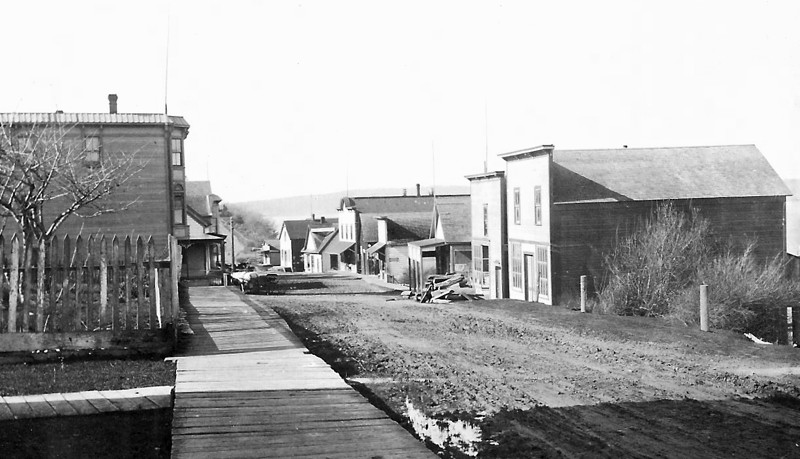
Front Street in the 1890s
The buildings on the North (right) side include the Robertson Store - the fifth one down
Courtesy: Island County Historical Museum, Coupeville
1883 - The building was Leased to A.D. Blowers & Albert Kineth.
Quote from "A Particular Friend, PENN'S COVE" by Jimmie Jean Cook
In March of 1883, the store was leased to A. D. Blowers and Albert R. Kineth. The same year he applied for permission to erect the dock which was in the space between the present restaurant and tavern. The County Commissioners agreed and fixed the wharf charges as follows:
Freight per ton -- not to exceed 50¢
Horses per head -- not to exceed 25¢
Cattle per head -- not to exceed 25¢
Calves per head not to exceed 10¢
Hogs per head -- not to exceed 5¢
Sheep per head -- not to exceed 5¢
June 1890 Blowers & Kineth moved next door. The building and warehouse were leased to Thornton & Nunan
1892 - Robertson sold the store & wharf to Thomas W. Calhoun.
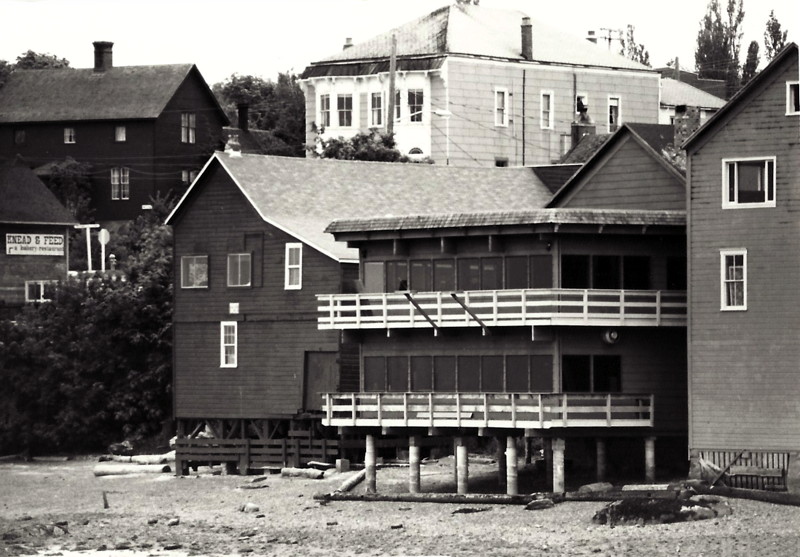
From the Coupeville Wharf
Courtesy: Island County Historical Museum, Coupeville
Quote from "A Particular Friend, PENN'S COVE" by Jimmie Jean Cook
In March 1892, Robertson sold the store and wharf to Thomas W. Calhoun for $6,500. The following year Calhoun transferred it to Samuel T. Calhoun. Spurgeon Calhoun recalls that for two years after graduation in 1894 from the Puget Sound Academy, he worked on the farm and at the Coupeville Grocery Store, hauling wood to the dock for steamboat fuel.
1893 - The building was transferred to Samuel T Calhoun.
1901 - Samuel Calhoun sold the property to Pauline Mutty who transferred it back to him.
Quote from "A Particular Friend, PENN'S COVE" by Jimmie Jean Cook
In 1901 Samuel sold the property to Pauline Mutty who transferred it back to him. In 1902 it was once again deeded to her and then to the LaConner Trading & Transportation Co. The partners of this firm were I. M. and E. E. Calhoun. The dock was retained by the Calhouns but the building was sold to George W. Vining who then sold it to W. A. C. Smith.
1902 - The property was again deeded to Pauline Mutty and then to LaConner Trading & Transportation Co (partners I.M. & E.E. Calhoun). Dock was retained by the Calhouns but the building was sold to George W. Vining who then sold it to W.A.C. Smith
1909 - The building was sold to Eva Fair. Henry Fair had a candy store for short time.
Quote from "A Particular Friend, PENN'S COVE" by Jimmie Jean Cook
In 1909 it was sold to Eva Fair. Henry Fair had a candy store there for a short time but in 1910 Eva leased to W. T. McCall "that certain bldg. situated on the north side of Front St. at the head of the old dock and between said dock and Kineth & Wiggens store for five years @ $15 per month.
1910 - Eva Fair leased the building to W.T. McCall. It became the Kineth & Wiggins Store
1912 - Mr. MCall gave bill of sale to C.H. Otto for stock & fixtures of Busy Bee Restaurant.
Quote from "A Particular Friend, PENN'S COVE" by Jimmie Jean Cook
In April of 1912, Mr. McCall gave a bill of sale to C. H. Otto for the "stock and fixtures of the Busy Bee restaurant in Mrs. Eva Fair's building." In 1916 it was rented to Sam Benson who sold candy and ice cream until he built the place now known as Howard's Gift Shop.
1916 - The building was rented to Sam Benson who sold candy and ice cream until he built a new place now known as Howard's Gift Shop [Kingfisher Bookstore].
1918 - Eva & Henry Fair sold the building to A.K. (Ollie) Capaan who opened a butcher shop.
1922 - Capaan sold 50% interest to Mr. Shirley M. Parker. Then Mr. Shirley Parker bought Capaan's [remaining] interest in late 30's early 40s.
*From an interview by Judy Lynn with Ilah Engom, in 2009
A building on the other side of dad’s grocery store was Mr. Parker and Mr. Capaan’s meat market (John Robertson Store).
*From an interview by Judy Lynn with Leone Argent, in 2009
When we were still in Coupeville: At first it was just Capaan that owned the meat market on Front Street. My mom was visiting her sister in Seattle and we were with my dad. Mr Cappan wanted my dad to work for him. This time dad said we could go to the movie. (At the Circuit Theater.) It was a Saturday night. My little brother said, "Dad may I keep the quarter and not go?" We stayed with dad. The meat market had sawdust on the floor and there was meat mixed in, and it smelled like a meat market. That's when Dad started our meat market. He said there would be no sawdust on the floor. Everything was painted white.
Next was the meat market owned by A.K. (Ollie) Caapan. (John Robertson Store building.) After a while he took a partner, Shirley Parker. The Parker's lived next to the Zylstra's. Luella Zylstra would bring Peggy Parker over to her house to baby sit and I enjoyed playing with her. I was happy to be there.
1948 - The building sold to Julius M. Konzelman who ran a restaurant & small grocery called Jule's Cafe.
1964 - The building was sold to Helen Williams. She opened the SeaGull Cafe.
*From an interview by Judy Lynn with Louise Holloway Stanley, in 2009
I remember enjoying a hot chocolate at the SeaGull restaurant (John Robertson's store). It was low-key and not fancy. I missed home when I first arrived. I was with a friend and she took me there. It was good to sip a hot chocolate at the SeaGull. Below in that same building there was a bar and they had live music—local bands and jamming.
1971 - 75 Bob McNally. McNally's operated as SeaGull
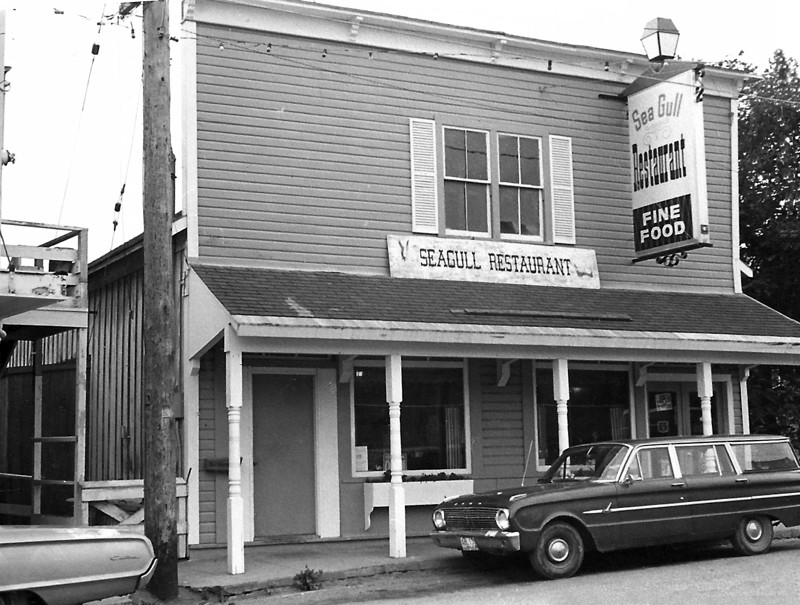
The SeaGull
Courtesy: Island County Historical Museum, Coupeville
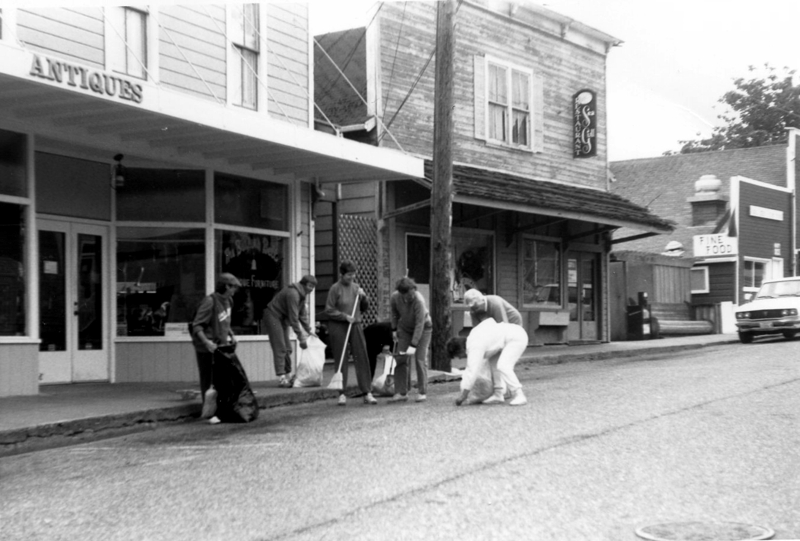
The SeaGull During a street cleanup after a festival in the 1980s
Courtesy: Island County Historical Museum, Coupeville
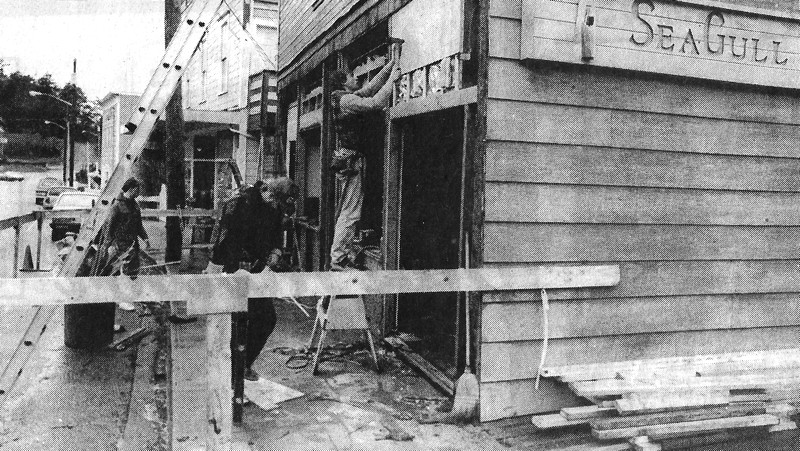
Renovation
Courtesy: A newspaper cutting at the Island County Historical Museum, Coupeville
1973 – Development permit applied for SeaGull Cocktails Cove Room
1976 - The Feds padlocked building in 1976 or 1977 (D. Kroon)
August 1980 - John & Linda Venetti opened Porto Fino
*From an interview by Judy Lynn with Bill and Jan Skubi, in 2010
Then John Venetti hired me to be his head chef at Port Fino. I was involved in the last year of the remodel of the building. (John Robertson store.) We had our big opening and the summer season of 1979. Jan and I were married September 22, 1979. I was head chef of Porto Fino and I was ready to go. John Venetti had a wonderful wedding reception for us at the Captain Whidbey. John provided wine and he hired Jean Paul Combettes as the chef for the event. Then we went to Harrison Hot Springs for a two week honeymoon and when I got back John said, "No Job." He had started cooking at the restaurant. So we started marriage with no job.
Judy: Tell me more about the Porto Fino.
Bill: It opened with great fanfare and for the summer season of 1979. It was the preferred hang-out for Dr. Kroll and Dr. Hanson. The opening was well attended. One contribution I made was a Sunday brunch. I went in at 8:00 am and started cooking. I didn't hang out for the wild nights. The bartender's name was Max and he was Italian. It was a routine - he would be stumbling around at 9 am and I would say, "Max, can I fix you some breakfast"? He would hold his head and say, "Not right now William".
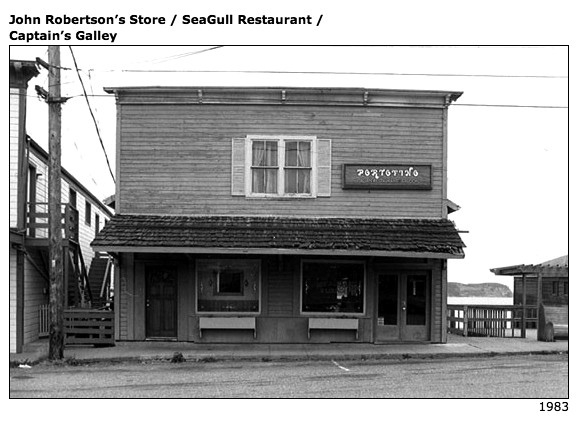
PortoFino
Courtesy: Ebey's Landing Building Inventory, 1983
*From an interview by Judy Lynn with John and Linda Venetti, 2010
Judy: You were the owners of the Portofino Restaurant at 10 Front Street (John Robertson's Store). How did you happen to come to Coupeville and open the business?
Linda: My sister, Nancy Hansen, called us telling us about a restaurant for sale. John dreamed of having a first-class seafood restaurant on the water. We had two boys. Johnny was three and Bo was one in 1978.
John owned Venetti's La Strada restaurant in the north end of Seattle from 1966 to 1976.
John: The restaurant on Front Street had been the SeaGull and had been closed for a year or more. We bought the building and business from Van Jones for $235,000, which included the 35' lot between Toby's (Whidbey Mercantile) and the SeaGull building.
Judy: Did you live above the restaurant?
John: We lived in the apartment above the liquor store (Benson's Confectionery). Above the restaurant was an unfinished empty room.
John: We started tearing the restaurant apart and that took over a year. We tore out the counters and just about gutted the building to build the stone fireplace. I was the contractor and I designed the fireplace. Chet Gladstone started the fireplace project but he kept running away. Then Brian took over that project. He spent $20,000 in materials so it cost about $30,000 to build. Larry Fritch, with the help of Jim Heath, did most of the building construction
The building was built in 1866 and a dock extended out between Toby's and the SeaGull. The stubs could still be seen at low tide when we owned it. An extensive remodel was done in 1973 and the dining room (on the street level) and the bar (on the lower level) were extended out over the water. The original building only went to where the front of the fireplace was. We gutted the building, redid the floors and walls (all done in oak), and put in a new kitchen. We raised the dining room and put planters around the outside with drains built in. The only thing that remained from the original restaurant was a walk-in cooler.
(Judy added a story of the SeaGull's black and red banquette she bought from the Venetti's and had moved to the living room of her home on Snakelum Point. "It was an unconventional, and pretty uncomfortable, couch. I had to have a window removed to move it in.")
Judy: I remember your beautiful tables and chairs.
John: We bought antique furniture from Betty and Jack MePhee, owners of Trader's Wharf (Terry's Dryer). We spent $50,000 for tables and chairs in sets of 2 and 4.
We opened on August 1, 1980. The opening was great but I was buried in the kitchen. Many friends came from Seattle and all over.
Linda: the restaurant was gorgeous. We had installed burgundy carpet. The tables had light pink cloths, brown napkins, and fresh flowers. We served Italian food and seafood, clams, ciappino, lasagna, steaks, mussels, salmon, and other fish that came by. We used to get a lot of fish locally.
The whole town wanted the neon SeaGull sign taken down which I did. But I waited awhile. I took it down the day before the (Coupeville Arts and Crafts) festival. Everybody clapped - Del Bennett particularly.
Judy: Tell me about your friends.
John: Linda and Ed Tis were good friends and they helped a lot. They ended up moving into (Easton) Mudget's old place in 1979—the "rock house" (on Broadway). Ed helped in construction and did a lot of woodwork. Ed and Mikal Park built the deck (between the Portofino and Toby's). Mikal Park built the bench.
Gail Sadalla was from San Francisco. She was pastry chef and more. Mikal was a good artist. We loved his mother too. (Note: Mikal's mother, Dorothy Park and her sister Mary Carr started the Wind n Tide Bookstore in Oak Harbor.) We were working most of the time and didn't socialize that much.
Judy: How did you arrive at the name Portofino?
John: I just liked the name. It was a little town in Italy on the water and reminded me of Coupeville.
Judy: Are you Italian?
John: I started working in Italian restaurants when I was 17. I was driving through Ventura on the way to Los Angeles and thought I would get a job faster if I had an Italian name so I changed my name from John Wilmot to John Venetti. I got a job right away. We were both born and raised in Seattle.
Judy: Was your business as a sole proprietor?
John: I had a partnership with a couple of crab fisherman—Orvin Kverneness, and Bill Peterson—a Norwegian and a Swede. They were regular customers in Seattle and it was their idea to start the business. The king crab business was good. They made a lot of money and they wanted to invest. There was also an Irianian banker who invested-- Ramazan Shamsi. Orvin and Bill were fishing most of the time and they didn't have an active role. We incorporated when the Iranian wanted to get into the business.
Then we bought a house off Swantown, overlooking West Beach, from Alan and Jan Dutcher before they built the Coupeville Inn.
In the interim I sold the business to Donald Rensink, who left after eight months and then it went back to me. He called it the SeaGull II . When Rensink went out we were forced to go back in and do something. We had obligations but didn't have money to reopen so we moved into the bar where we lived for six months before it went into foreclosure. Van Jones was foreclosing. We had bunk beds for the boys back where the fish tank was.
I was given a year by the court to redeem it but I didn't want to. I represented myself in court and Judge Patrick let me use his office to study. Van Jones would have had to pay me for the year. In the meantime the fisherman in 1979 were supposed to have the funds to buy out the Iranian banker but the king crab business stopped. They were unable to help. The last year it was the Portofino was 1982.
Then I met Red Brainbridge and I've been in the dump ever since.
Later on Gerrie Ryan had the restaurant and renamed it Ryan's Landing. She tore apart everything I put in. She came out to the dump and asked me to manage the restaurant. She didn't know what she was doing but didn't know it. The next winter I agreed to manage it if she would stay out of it. I opened in April and got the business going good and she came back and decided to change stuff and I left. Linda and Johnny continued working for her after I left.
She asked what it would take for me to come back. I said "A week in a cabin in the mountains." I told her I would give her my answer then. I advised her to close the restaurant until I got back but she didn't. I came back a week later and told her I didn't want to come back. I gave her the recipes and she continued inadequately. She was a nice lady. The restaurant was going to be a hobby. She was a realtor and had never been in the restaurant business. She spent a lot of money on managers and chefs that bailed out on her before they opened. I believe she bought the building for $550,000. The business had been closed.
(Judy added that Gerri had generously hosted a number of events and art exhibits for the Coupeville Arts Center while she had the restaurant.)
Judy: What was it like doing business on Front Street?
John: It was great in the summer and dead in the winter. The congeniality was good. Everybody got along well and they were supportive. Michael Anter was running Mike's Your Place (Cushen Ford Garage); the McPhee's had Trader's Wharf (Terry's Dryer). I had a lot to do with them. George Lloyd was running the Butler's Bell in Dr. Kroll's building (Coupeville Cash Store). Gary Kelly had a gold prospecting shop selling gold jewelry. He had been a gold prospector. His shop was in the back part of the parking lot on the street level (Grace Street in a building that is no longer there) and later he moved it to Mariner's Court (Cushen's Ford Garage). Del and Shirley Bennett had an antique shop in the McPherson's building (Glenwood Hotel); Rose Brosseau had the Six Persimmons across from Toby's (John Robertson's house) and Virginia Lehr had the Honey Bear in Mariner's Court.
Judy: Do you remember cars that Jack McPhee had for sale parked on the sidewalk in front of Trader's Wharf?
John: Yes. Most of them were English. Jack had a couple of Rovers and old Jag and an old taxi from Scotland.
Judy: What are your favorite memories of the restaurant business?
John: I enjoyed the view - being a place exactly like I wanted with a kitchen just for me - and the people that participated. We had a great crew. Serving great meals was part of cooking. I had a lot of good writeups when we first opened. The Vancouver Sun wrote a large article, unsolicited. I had job offers from Seattle and even Japan. It was a big success—until winter came. There was the expense of lights and the bar. It was fine for the tourist. We opened a big city restaurant in a small town. We had a local bar trade, but not enough to keep it going. With two levels we had to have a minimum of six people working and it was too much overhead.
In 1980 when I first opened I went down to the crab boat and I had a whole pickup load of live king crab. We had 1,000 lbs of just crab legs. Ron Burch got the bodies. We sold a lot of crab at the restaurant and I gave most of it away.
We followed Linda and Ed to Pleasantville California in 1985 and moved back to Seattle a year later.
1982 - Porto Fino closed
1990 - Gerrie Ryan became owner.
1991 - The building was called Ryan's Landing and was opened by Gerrie Ryan in June.
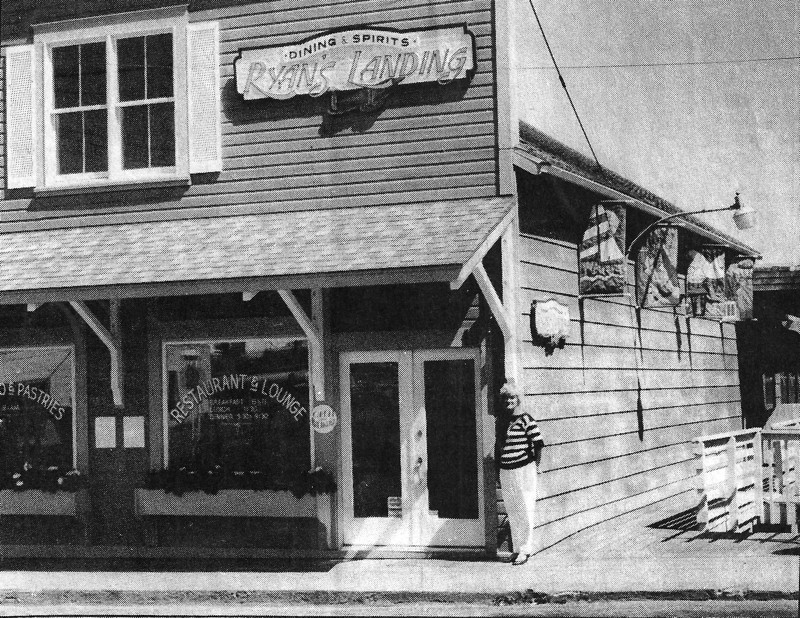
Gerrie Ryan in front of Ryan's Landing
Courtesy: A newspaper cutting at the Island County Historical Museum, Coupeville
1992 - The restaurant became Captain Jack's Galley and was run by Harry Nevar.
1995 - The restaurant became the Mad Crab run by Jack and Melissa Lamy.
*From an interview by Judy Lynn with Barry Burton, 2009
Van Jones bought the building and John Venetti opened Portofino, and then it was Ryan’s Landing (we called it Ryan’s Hope) then Harry Nevard opened Captain’s Galley. They sold to Jack and Melissa Lemay.
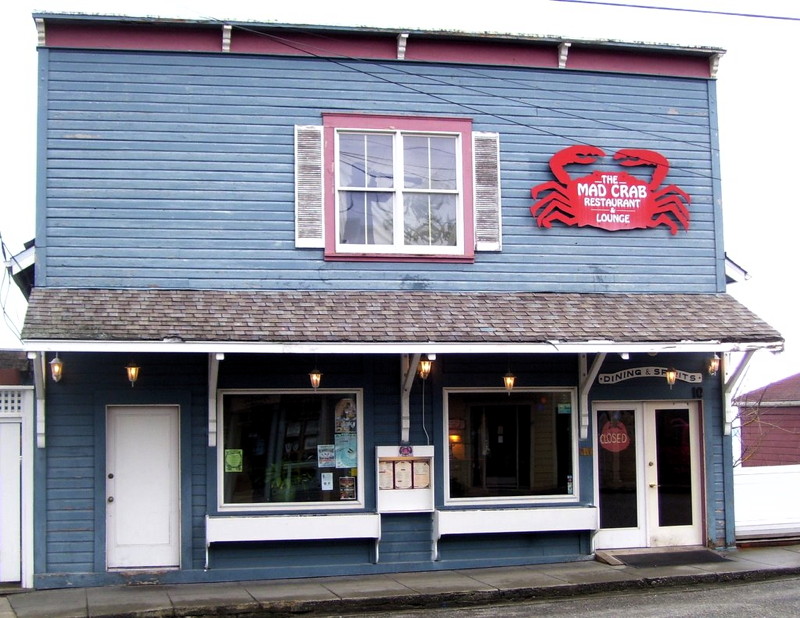
The Mad Crab Restaurant complete with sailor at telescope in the upper window
Courtesy: Robert Elphick, 2005
2007 - The deck was repaired.
2007 - The Mad Crab closed. It was called Captain Jack's that year for the spring, summer and fall seasons.
2013 - The building was purchased by Thom Kroon, who also has a part ownership of the Knead and Feed Restaurant.
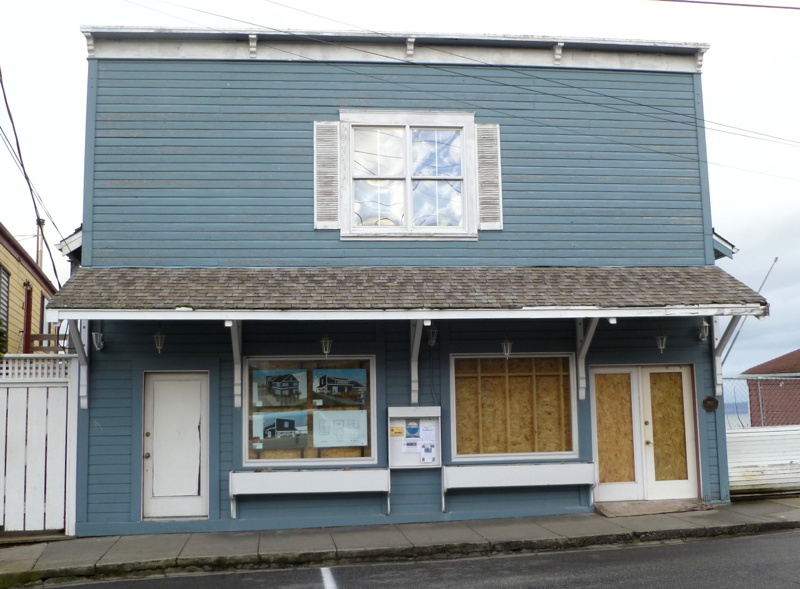
The Building unoccupied.
Courtesy: Robert Elphick, 2015
Down to stud renovation 2017 thru 2019
2019 - Rain Puddles Kids Boutique - sells and Kids clothing and accessories. Fine fabrics and design.
More shops expect to open soon.
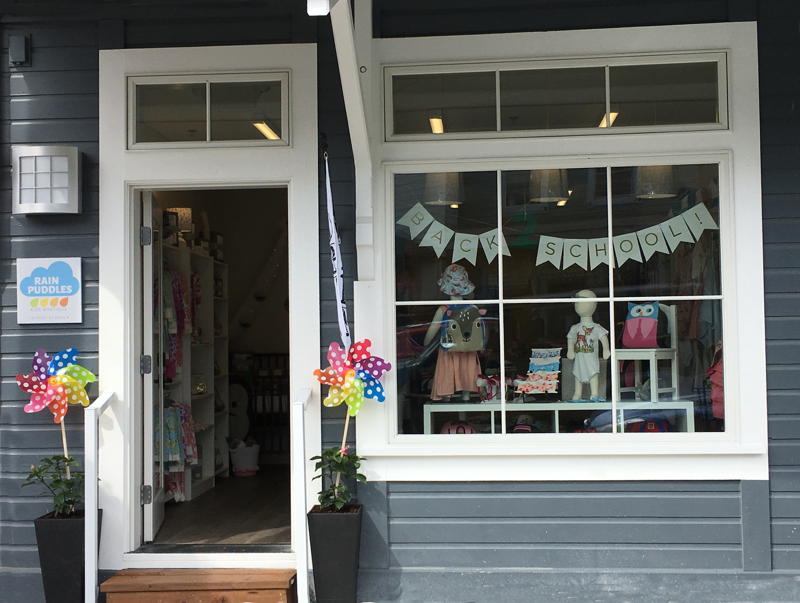
Rain Puddles
Courtesy: Gwen Samelson, 2019
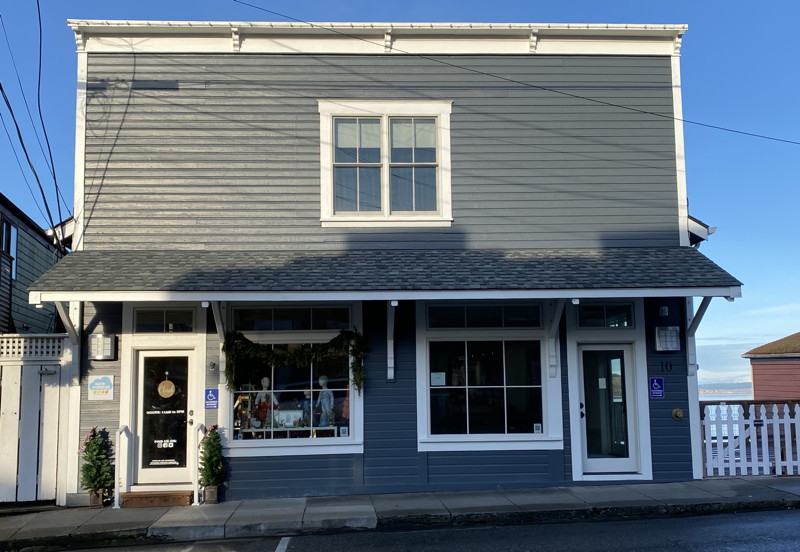
Building with Rain Puddles
Courtesy: Robert Y Elphick 2019
* All the interviews are extracted from the Judy Lynn's Oral History Project. Judy Lynn interviewed everyone she could find who had any memories of the history of Front Street. For more information on the project contact the Whidbey Island Historical Musem, Coupeville.
The e-book Front Street, Coupeville - An Oral History by Judy Lynn contains all the interviews. It can be purchased for $9.99 at Amazon.com for Kindle application or device or from the Apple Store for iBooks applications. Proceeds go to the Island County Historical Society.


